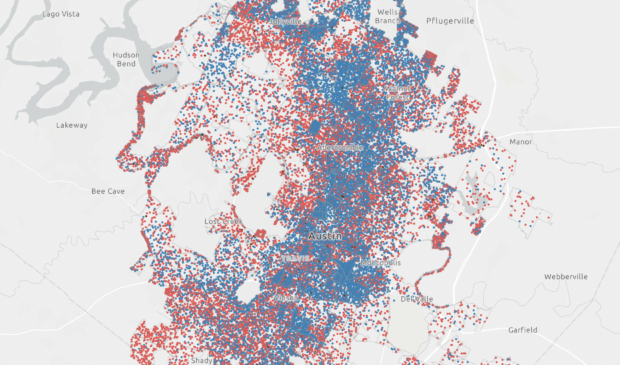Demography map shows 90,000 new housing units wasn’t enough for Austin’s growth
Tuesday, November 28, 2023 by
Chad Swiatecki A new interactive map released by the Planning Department shows some of the ways Austin’s housing supply has changed dramatically over the course of a decade in which the city has become one of the most popular destinations in the U.S.
The city Demography Division’s Demography Story Map reflects how even though Austin added 90,000 housing units from 2010 to 2020, surrounding communities outpaced the city’s rate of housing growth. The shift meant that over the course of the last decade, the city’s share of housing in the five-county region accounted for less than half the total, or 47 percent of all housing.
Other findings include that the vacancy rate in ownership and rental units both decreased overall from 8.3 percent to 7.6 percent, which the report notes an indication of several market factors including high demand, low supply or a mix of both. The bulk of Austin’s housing supply as of 2020 consisted of 59.3 percent rental units, with 38.8 percent units intended for ownership. Maps showing locations of rental versus ownership units generally reflect the city’s Eastern Crescent socioeconomic dynamic, with the bulk of rentals located in a backward “C” shape east of Interstate 35.
Walter Moreau, executive director of the Foundation Communities affordable housing nonprofit group, said the study doesn’t reflect the recent increase in housing production, such as 60,000 apartment units scheduled for completion in the next two years. By email, Moreau said that increase in supply will cause more price competition, but the city and philanthropic groups will still need to allocate resources to provide housing affordable for lower- and middle-income households.
“Market forces really drive housing development. As Austin adds jobs, then demand for housing increases as well. However, the market will never supply enough housing at a low enough rent or price for families that make well below the median income,” he wrote. “We need more housing development to meet the demand, and a tremendous amount of new housing is in construction right now, however, rents are unlikely to drop enough for those with very low incomes. If we want Austin to remain a diverse community, then we need more housing production, especially for the lowest-income households that will otherwise be priced out.”
João Paulo Connolly, organizing director for the Austin Justice Coalition and member of the Planning Commission, said the raw numbers in the maps may suggest the city is adding adequate housing supply to keep up with demand. As an indicator of the city’s continued popularity, Austin is the No. 9 city for millennials, with residents aged 25 to 44 making up 11 percent of the city’s population, the financial technology company SmartAsset recently found.
“If people just look at the hard numbers around numbers of new units added and percentage of new units added, then people think, well, Austin is really building tons of housing,” Connolly said. “You have to look at the actual growth rate of the region. … We have a picture where I think Austin is clearly not adding enough housing, and the surrounding areas are making up for the lack of housing.”
Connolly said recent moves such as the HOME initiative to increase the number of units allowed per lot will likely help the city increase its housing supply, but he hopes the Planning Commission and other city bodies will continue to look for new ways to address the city’s growing pains.
“As a Planning Commission, we are tasked with some very clear mandates, and one of them is with the successful implementation of the city’s Imagine Austin plan and all of the other plans that are embedded in it,” he said. “If we take those goals in our Imagine Austin plan and compare them to the picture that is being painted in this demographic map, it is very clear that we are failing pretty radically at meeting these goals that we have set for ourselves as a city.”
The Austin Monitor’s work is made possible by donations from the community. Though our reporting covers donors from time to time, we are careful to keep business and editorial efforts separate while maintaining transparency. A complete list of donors is available here, and our code of ethics is explained here.
You're a community leader
And we’re honored you look to us for serious, in-depth news. You know a strong community needs local and dedicated watchdog reporting. We’re here for you and that won’t change. Now will you take the powerful next step and support our nonprofit news organization?






